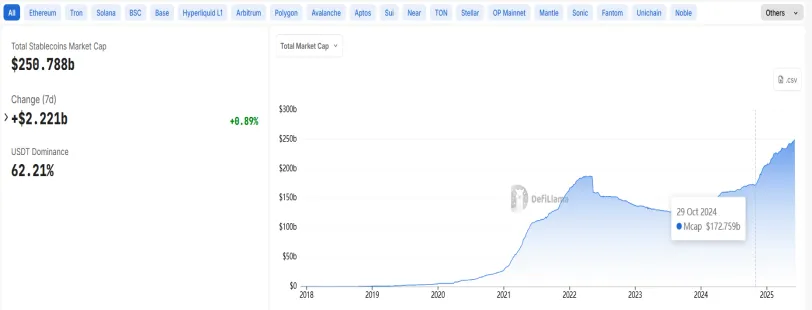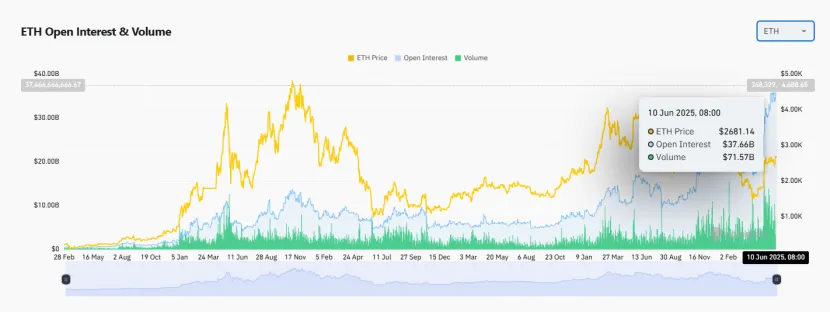Trend Research: On the eve of the surge, why are we optimistic about ETH

Reprinted from chaincatcher
06/12/2025·5DYesterday, ETH and ecological blue chip targets ushered in a price surge, with ETH rising 6.4%. The UNI mentioned in our previous research report rose 24.4%, AAVE rising 13.1%, and ENA rising 6.6%. In this round, Trend Research integrates knowledge and action. Since its establishment of a position of US$1,400, it has been optimistic and increased its holdings of ETH related targets, and has recently purchased ETH call options, becoming the earliest secondary investment institution on the entire network that Ming Card is optimistic and opens its position address.
At present, we are still optimistic about the underlying logic of ETH: the Trump administration is committed to establishing a stablecoin system, taking advantage of blockchain decentralization and on-chain characteristics to absorb M2 liquidity from other countries around the world, thereby increasing the demand for US bonds. To this end, the Trump administration has relaxed macro-regulation of encryption, promoted the implementation of regulatory measures, and regulated encryption from all aspects to accommodate more funds. The most important facility for stablecoins and on-chain finance (DeFi) is Ethereum. The influx of stablecoins and the continuous development of RWA will bring about further prosperity of DeFi, driving the increase in Ethereum consumption and GAS revenue, and pushing up its market value.

1. Continuously optimistic crypto supervision
(I) Changes in the concept of encryption supervision
The Trump administration is a crypto-friendly government. SEC Chairman John Atkins, who took office in April 2025, has clearly promoted the transformation of crypto assets regulation.
1. Simplify the public statement of the process
Rules take precedence over law enforcement: Atkins criticized the former’s model of “defining compliance through litigation”, emphasizing that clear and predictable rules will be formulated to reduce industry uncertainty.
Classification regulatory framework: It is planned to release token classification standards within 90 days and establish a "safe harbor" system for compliant projects.
2. Long-term policy direction
On-chain securities compliance: Atkins proposed to explore "on-chain stock exchange listing" in May 2025, which may reconstruct the issuance and trading process.
Cross-sectoral collaboration: Plan to cooperate with CFTC and FTC to establish a joint regulatory framework to reduce jurisdictional conflicts.
DeFi is in line with the core American values and will launch a "innovation exemption" framework.
(II) Further improve and relax the framework of the encryption supervision bill
1. "CLARITY Act"
CLARITY Act aims to build a structural regulatory bill for the crypto market to effectively resolve the regulation of the digital asset market with a scale of $3.3 trillion . The first is to clarify asset classification, distinguish between securities tokens (regulated by SEC), commodity tokens (regulated by CFTC) and licensed payment stablecoins, and resolve long-disputed "securities or commodities" identification issues. The second is to regulate institutional supervision, and require financial institutions custodial digital assets to meet the requirements of capital reserves and isolate customers' funds, and prevent risks similar to FTX. The bill was passed by the U.S. House Committee on June 11, 2025 with 47 votes in favor and 6 votes against, and will be handed over to the House Financial Services Committee for the next stage of consideration.

According to the bill, mainstream cryptocurrencies such as Bitcoin and Ethereum are commodity tokens, and company equity tokens (representing the company's ownership and enjoying voting rights or dividend rights), bond tokens (promising fixed interest returns), and income dividends with DeFi governance tokens (relying on the project party to continue operating) are securities tokens. This will change the previous state of being unclear, unclear law enforcement, and thus being at a loss. The clarity of rights, responsibilities and obligations will help promote the prosperity of the DeFi platform.
The probability of mainstream infrastructure tokens like SOL may be recognized as commodities is increasing. On June 11, the SEC has asked potential Solana ETF issuers to submit revised Form S-1 within next week. The SEC stated that it will provide feedback on Form S-1 within 30 days of submission. This shows that regulators' recognition of crypto-merchandise is relaxing and accelerating.
2. Genius Act
" Genius Act" aims to fill the gap in stablecoin regulation, strengthen the dollar's position as the world currency, and solve the dilemma of US debt demand. This is the first comprehensive regulatory framework for stablecoins at the federal level, which clearly defines the qualifications, reserve requirements and operating specifications of the issuing entity. The mandatory requirement for stablecoins to be anchored 1:1 with the US dollar, pushing the US dollar to penetrate into the global crypto economy and cross-border payments through stablecoins, and consolidating the US dollar's dominance in international finance. Through mandatory reserve rules (requiring that reserve assets are short-term US Treasury or cash), we will create structural demand for the US Treasury market and alleviate US fiscal pressure.
In the past few years, the stablecoins USDT and USDC have repeatedly reported regulatory risks and redemption risks, resulting in more than 10% of them being deaned. If it can be included in federal regulation, it will undoubtedly help strengthen the security and credit of stablecoins. At the same time, after the federal legislative attitude is clear, more issuers will participate in the issuance of stablecoins and absorb more funds to enter the crypto market. Standard Chartered Bank predicts that the scale of stablecoins may increase to US$2 trillion in 2028 after the bill is passed.
3. Relaxed regulation on the issuance, custody and transaction of crypto assets
SEC Chairman Atkins mentioned in his speech that more relaxed supervision will be carried out in three key areas of crypto assets - issuance, custody and transactions.
In terms of issuance, the SEC will formulate clear and reasonable guidance for the issuance of crypto assets under the constraints of securities or investment contracts. So far, only four crypto asset issuers have issued securities under Regulation A. Regulation A is a simplified issuance exemption mechanism for small projects proposed by the US Securities and Exchange Commission. Issuers with a certain amount can issue stocks and bonds through this mechanism. Since the biggest policy obstacle to the issuance of crypto assets is the unclear determination of whether the nature of the asset belongs to securities and what type of securities it belongs to, the issuer is worried that issuing crypto assets violates the corresponding legal terms, which leads to few projects using this rule. Atkins asks SFC staff to consider making crypto assets issued in the United States smooth through work-level business guidance, registration exemptions and safe harbors.
In terms of custody, registrants are supported to have greater autonomy and selectivity to determine how to custody crypto assets. Investment advisors and fund companies can use self-custody solutions that are more advanced than current custodian technology to preserve crypto assets. This is mainly due to historical reasons. The traditional custodians have insufficient informationization and cannot adapt well to the needs of blockchain.
In terms of trading, investors can support a wider range of trading types on trading platforms. The trading platform can provide transactions of securities assets, non-security assets, and even provide sales of other financial services. Staff have been asked to explore whether there is a need to specify some guidance or rules to enable crypto assets to be listed and traded on national stock exchanges.
4. DeFi is expected to implement "innovation exemption"
SEC Chairman Paul S. Atkins made it clear at the roundtable "DeFi and the American Spirit" on June 9, 2025: "The basic principles of DeFi (economic freedom, private property rights, de-mediation) are highly consistent with the core values of the United States. Blockchain technology is a revolutionary innovation, and the SEC should not hinder its development."
The SEC is developing conditional exemption rules for DeFi to quickly allow registrants and non-register parties to bring on-chain products and services to the market. Innovation waivers can make the United States a “global crypto capital” by encouraging developers, entrepreneurs and other companies willing to comply with specific conditions to carry out on-chain technological innovation in the United States.
UNI was previously troubled by compliance. Although it was the most important DEX on the chain, its currency price performed poorly. If the innovative exemption rules can be applied quickly, UNI may be the first beneficiaries. This is also one of the important reasons why the top DeFi coins have risen sharply after the roundtable.
5. Ethereum ETF staking approval expectations
On May 29, 2025, the U.S. Securities and Exchange Commission (SEC) Department of Corporate Finance issued a statement, clearly stating that certain pledge activities of blockchain protocols based on Proof of Stake (PoS) do not constitute securities transactions. Atkins' speech at the DeFi and the American Spirit roundtable also further clarified that "voluntary participation in the proof-of-work or proof-of-stake network as a "miner", "verifier" or "staking as a service" provider is not within the scope of the federal securities laws." And it will promote the formulation of relevant regulations, which means that Ethereum's staking activities (including node self-staking and staking through service providers) will not be considered securities transactions if specific conditions are met, and it also paves the way for the currently passed Ethereum ETFs to be pledged.
If the SEC may approve Ethereum ETFs containing pledged income, it will enable institutional investors to obtain ETH pledged income through ETFs. ETH will become a "bond" in the crypto industry, and a huge amount of traditional institutional funds will legally flow into ETH. On the one hand, a large amount of ETH will be locked by pledge, which will further improve the decentralization and security of on-chain finance. On the other hand, the compliant on-chain income will significantly increase the demand for ETH and push up prices.
To sum up, the Trump administration is conducting more systematic and adaptive supervision of crypto assets and markets, with supervision becoming clear and loose, encouraging blockchain innovation to absorb more funds into crypto.
**2. Ethereum is still the most important infrastructure for on-chain
finance**
The implementation of the "DeFi" statement and specific bills will break the barriers of compliance in the future and open up channels for traditional funds to enter. trillions of incremental funds will come to on-chain finance in the form of stablecoins. The largest and most secure "soil" of on-chain finance is Ethereum.
(I) Current status of stablecoins issuance and distribution
1. Total amount of stablecoins
Since Trump took office, the total amount of stablecoins has increased by about $76 billion, with a seven-month increase of more than 40%. This growth rate significantly exceeded the total increase in stablecoins during the bull market recovery in 2023.
In September 2023, the total stablecoin volume reached its lowest market value in nearly four years of approximately US$123.7 billion, and increased to US$173.7 billion by November 2024, an increase of US$50 billion, an increase of approximately 40% in 13 months.

2. Current status of stablecoins distribution on the chain
About 50% of stablecoins are circulating on Ethereum, 31% on TRON, 4.5% on the Solana chain, and 4% on the BSC chain. Ethereum accounts for half of the liquidity of stablecoins.

3. The ecological status of major public chains and the stablecoins in DeFi

From the comparison of the above figure, we can see that more than 50% of funds on Ethereum are deposited in the DeFi protocol and have the largest DeFi TVL. Although Tron has a large number of stablecoins, it is mainly used in payments, with a small number of ecological protocols, and DeFi TVL accounts for only 6.5%. Although the proportion of DeFi TVL of Solana and BSC is relatively high, its absolute value is relatively small, and its DeFi infrastructure is average.
Based on the above, when the stablecoin bill is passed, Ethereum will most likely take over the largest amount of funds entering.
(II) New stablecoin flow
It is currently speculated that there will be four flows in new stablecoins:
1. Flow to the DeFi market native to the crypto market and has a higher yield
Crypto's high volatility makes the chain have many DeFi protocols that are far higher than the traditional financial market and are convenient to enter. When incremental stablecoins enter the chain, some funds will inevitably choose more intelligent, efficient and profitable investment opportunities. Ethereum's high degree of decentralization, security and scale will become the first choice for incremental funds to enter this part. Among them, UNI, as the largest on-chain Dex and AAVE, as the largest on-chain lending protocol, is a blue-chip target that cannot be ignored. Small-cap DeFi protocols such as COMP, such as small-capital value, are also worth paying attention to.
Among DEXs, UNI is currently in a clear advantage, with TVL being US$5.1 billion, 7-day trading volume US$17.6 billion, and 7-day fee income of 19.26 million, and its TVL is significantly higher than other DEXs.
The more special one is Pancake, which has a 7-day transaction volume of US$33.4 billion and a 7-day fee income of 56.81 million. Its trading volume is significantly higher than UNI, mainly benefiting from Binance alpha volume trading.

In the lending field, AAVE is in an absolute dominant position, with TVL26.4 billion, 7-day expenses of 11.68 million, and 7-day agreement revenue of 1.49 million. TVL in the remaining lending markets is less than $5 billion.

2. Flow to the RWA market built mainly with US compliance agencies
Many traditional funds will not participate too much in the altcoin market when entering the chain, but will enter the RWA market built by leading institutions of financial innovation in the United States, such as the BUILD fund issued by BlackRock on the chain.
BUIDL funds mainly invest in: cash: high-liquid cash or cash equivalents to ensure the stability of the fund and the ability to redeem instantly; US Treasury bonds: short-term US Treasury bonds, which provide a stable source of returns as low-risk, high-credit rating assets. Repurchase Agreement: Short-term lending agreements, usually mortgaged by Treasury bonds, ensuring the liquidity and income of the fund. The combination of these assets is designed to maintain the stable value of the BUIDL token (targeted at USD 1/token) and to distribute dividends to investors through daily accumulated earnings, issued monthly in the form of new tokens. The fund is managed by BlackRock Financial Management, with the custodial party being Bank of New York Mellon and the tokenization platform being Securitize.
Platform management TVL has grown rapidly in the past three months. In March 2025, TVL just exceeded US$1 billion, and has now increased to US$2.87 billion, an increase of 187%; of which US$2.687 billion is on Ethereum, accounting for 93% of the total.

Native projects in the currency circle are also closely following the RWA market. USDC issuer Circle acquired USE currency (USYC) issuer Hashnote to make up for its business shortcomings in RWA.
Hashnote is a $5 million startup incubated by Cumberland Labs, focusing on tokenized US bond products. Its core product, USYC (US YieldCoin), has anchored short-term US Treasury bonds, with a scale of US$1.3 billion as of the time of acquisition. Circle deeply binds USYC with USDC to create a closed loop of "cash + income assets" to meet institutions' dual needs for on-chain collateral and income tools.
In addition to BUIDL and Circle, large RWA projects include ENA and ONDO. The problem with ENA is that it is mainly used for arbitrage of fund rates in crypto token contracts. The market size is limited by transaction size, and there is also a learning cost issue for outsiders' funds, so there has not been much growth in the past six months. ONDO has increased from 600 million to 1.3 billion since the beginning of 2025, an increase of about 116%. It can be seen that although the stablecoin bill has not been fully passed, debt tokenization is already underway. In addition, Chainlink is also very important in RWA, and is the largest oracle for off-chain assets to be linked and integration with on-chain Defi.
3. Flow to the payment field that solves traditional financial efficiency
Traditional funds have become stable coins, and a very important purpose of entering blockchain is to solve payment problems, such as optimizing the traditional SWIFT payment system and improving transaction efficiency. For example, JPMorgan’s Kinexys platform (formerly Onyx) focuses on wholesale payments, cross-border payments, foreign exchange transactions and securities settlement. Support multi-currency cross-border payments to reduce intermediaries and settlement time. Provide the tokenization function of digital assets and explore payment scenarios for stablecoins and tokenized bonds. Kinexys is also based on the Ethereum technology stack, utilizing its smart contract and distributed ledger technology. Currently, the average daily trading volume of Kinexys has exceeded US$2 billion.
4. Flow to some crypto-native hype markets
A small part of incremental funds will quickly flow to the crypto-native altcoin speculation market.
To sum up, compared with other on-chain ecosystems, Ethereum and its on-chain DeFi are the largest increase in stablecoins. On-chain DeFi may usher in a new "DeFi Summer" and further demand for staking to promote network security in 2025. At the same time, the SEC's "DeFi" statement on June 10 may pave the way for ETH's ETF pledge. If it is successfully passed in the future, ETH will become a "bond" in the crypto market, triggering large-scale purchases. A series of changes may push ETH into a deflation again (current annual inflation rate is 0.697%).

**3. The contract market has a new high position, and short sentiment is
still there; spot ETFs continue to flow in, options are on the rise**
1. New high contract position
Currently, ETH still has about 40% increase from ATH, but the contract holdings on the entire network have reached a record high of US$37 billion, and the contract market is extremely liquid.

2. The high point of market sentiment has not yet arrived
At the same time, the current market sentiment has reached its peak in the future. The fear and greed index has just shifted from neutral to greed. The high point of intra-market sentiment has not arrived, and the incremental funds off-market have not yet begun to enter.

3. The number of short sellers on the exchange increased
Judging from the long-short ratio of exchange contract positions, the ratio of long-short positions continues to decline, while the number of short positions is increasing. At the same time, positions are continuing to rise, so overall short positions are also rising.

Before this, when ETH continued to fall to 1400, the entire network was bearish. According to our observation, a large number of short orders have accumulated on the entire network, and a large number of naked short behaviors have occurred in mainstream coins and altcoins. When the entire network released a research report on the trend reversal in April, we observed that some exchanges had ETH holdings far lower than the exchange contract holdings. At present, this situation still exists. Bybit exchange holds 1.44 million pieces, and the exchange wallet balance is 316,000 pieces, which is 4.5 times the balance; Gate exchange holds 1.96 million pieces, and the exchange wallet balance is 166,000 pieces, which is 11.8 times the balance. The Bitget Exchange's holdings are 1.52 million pieces, but the exchange wallet balance has not been disclosed yet.
4. CME contract position is new


Judging from CME's data, the current ETH trading volume in CME has not reached a new high, but the open contract volume (OI) has reached a near-alerial high. From the perspective of long and short situation, non-commercial traders held 18,699 contracts long positions, 19,572 contracts short positions, and 873 contracts short positions, indicating that speculators in the futures market bearish sentiment is mostly. If 30%-40% of non-commercial traders' short positions are hedged, then naked short positions account for 60%-70%. Based on the price of US$2,750, the naked short positions of speculators on CME are approximately US$1.6-1.8 billion.


5. AAVE lent ETH 6.8 billion

According to the AAVE data of the largest lending agreement on the chain, we can see that the current loan amount of ETH on the chain is about US$6.8 billion. These loans will not be completely hedged according to market common sense. Many parts will be leveraged short selling. We speculate that the amount of this part of the naked shorting is not less than US$1 billion.
6. Spot ETFs continue to be net inflows, and the options market is on the rise
Through futures derivatives data, we believe that the current market bearish sentiment is still there and there is a billion-level naked short situation, but the options and spot markets reflect a certain degree of bullish layout.
In the spot market, ETH ETF reversed its previous weak state and continued net inflows in the past 15 days. On June 10, the net inflow of one day reached US$125 million, and the cumulative inflow of US$450 million in June. Among them, BlackRock bought US$360 million, which was the main buying force, showing a bullish trend.

BlackRock ETH spot ETF positions change as follows, and it has been continuously increasing since May 2025.

BlackRock is selling some BTC spot and instead buying ETH spot.

Deribit shows that the number of call options among open options is far higher than put options. The options delivered before June 20 are not much different, but the call options are significantly higher than bearish among options traded after June 20.

Clearing monitoring shows that ETH shorts worth $2.1 billion will be liquidated at $3,000, and the market will squeeze these shorts, which is expected to push ETH to $3,000 in the short term.
7. Ethereum Vault SBET brings new demand
In the context of crypto-friendly and loose supervision, many companies have appeared in the US stock market to imitate MSTR model and purchase mainstream tokens such as BTC, ETH, and SOL as underlying assets.
Joe Lubin, co-founder of Ethereum and founder and CEO of ConsenSys, announced that he will serve as chairman of the board of directors of SharpLink Gaming (stock code: SBET) and lead its $425 million Ethereum vault strategy. The Ethereum vault will be an active vault. In addition to enjoying the benefits brought by the rise in token prices, most ETH tokens will be used for pledge and are active participants in network security. Investors can also obtain at least 2% of pledge income. This model will bring new demands to ETH.
In summary, we believe that ETH spot is still in the stage of continuous inflow and options are bullish; at the same time, the market's bearish sentiment is still there, and there may be a billion-level naked short behavior. Prices have broken through the key branch resistance swap zone and further broke through the short-term resistance level. The accumulated short positions in the long term may further promote the continued rise. In conjunction with the relaxation of digital currency regulation, the gradual increase in the market value of stablecoins and the gradual growth of Ethereum vault strategy in the US stock market may exceed US$14,000 in the medium and long term.
4. Summary
The United States has further systematic, standardized and clarified the regulation of cryptocurrencies, and simplified the issuance, custody and trading procedures of crypto assets, promoted the issuance of stablecoins, and explored the development of innovative assets such as DeFi and RWA. All of these measures will expand the scale of crypto assets. Ethereum has the most mature on-chain financial ecosystem and is most likely to undertake funds brought by stablecoin compliance. DeFi projects and RWA projects built on it will also benefit from this and achieve long-term development.


 jinse
jinse

